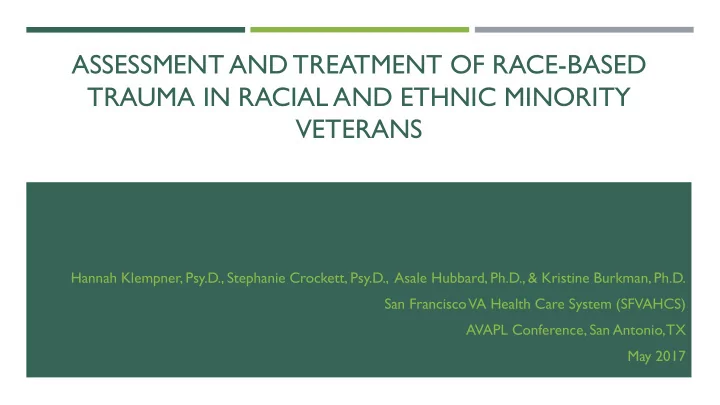

ASSESSMENT AND TREATMENT OF RACE-BASED TRAUMA IN RACIAL AND ETHNIC MINORITY VETERANS Hannah Klempner, Psy.D., Stephanie Crockett, Psy.D., Asale Hubbard, Ph.D., & Kristine Burkman, Ph.D. San Francisco VA Health Care System (SFVAHCS) AVAPL Conference, San Antonio, TX May 2017
DISCLOSURES None of the authors have relevant financial or nonfinancial relationships to disclose.
OUTLINE Theoretical underpinnings Assessment measures Treatment approaches Recommendations
BACKGROUND Exposure to racism can have a detrimental impact on physical and emotional well- being 1,2 Higher rates of PTSD symptoms in OEF/OIF and Vietnam minority veterans 3,4 Exposure to race-related stressors is a predictor of PTSD 5 Race-based trauma is under-evaluated and under-reported in clinical settings 6 1 Harrell (2000), 2 Bryant-Davis, & Ocampo (2006), 3 Koo, Hebenstreit, Madden & Maguen (2016); 4 Kulka et al (1990), 5 Loo, Fairbank, & Chemtob (2005), 6 Scurfield & Mackey (2001)
REFLECTION
Race Based Traumatic Stress Injury (Carter, 2007) Racial Discrimination Avoidant : barring access, Reaction Signs/ exclusion, withholding Symptom Cluster information and use of deception Flashbacks Nightmares Event Critical Memory loss Unpacking Experienced As: Racial Harassment Signs: Inability to Racism: Hostile : physical, Negative (emotional pain) Avoidance concentrate interpersonal and verbal Individual Sudden Hyperactive assaults, treatment as Intrusion Institutional Depression stereotype, assumptions Uncontrollable Arousal Poor relationships as criminal or dangerous Cultural Withdrawal Guilt Discriminatory Increased vigilance Harassment Spiritual Aversive-hostility : “White Activism flight,” isolation at work, Commitment to being denial of promotion, strong question of qualifications
ASSESSMENT OF RACE-BASED TRAUMA It is difficult to obtain an accurate assessment using traditional methods 1 One size … Ethnoviolence occurs at many levels and takes different forms Single incident vs. accumulation of stressors … does not Existing measures have limitations and are under utilized 2 fit all! Perceptions of Racism Scale, The Schedule of Racist Events, Race-Related Stressor Scale, Race- based Traumatic Symptom Scale 1 Helms, Nicolas, Green (2010); 2 Waelde, Pennington, Mahan, Mahan, Kabour, & Marquett, (2010).
TREATMENT OF RACE-BASED TRAUMA RCTs include predominantly White participants 1 Treatment protocols do not explicitly address race-based trauma Instead, treatments may be adapted to fit the individual needs of patients 1,2 1 Helms, Nicolas, Green (2010); 2 Comas-Diaz (2012)
ADAPTING COGNITIVE-BEHAVIORAL INTERVENTIONS Avoiding challenging whether events are racially motivated In vivo exercises that focus on tolerating emotional response to the possibility of racism Discussing the impact of racism on beliefs around Safety, Trust, Power/Control, Esteem, Intimacy Williams et al. (2015)
RECOMMENDATIONS Communication Empowerment Support
REFERENCES Bryant-Davis, T., & Ocampo, C. (2006). A therapeutic approach to the treatment of racist-incident-based trauma. Journal of Emotional Abuse, 6 (4). Bryant-Davis (2007). Healing requires recognition: The case for race-based traumatic stress. The Counseling Psychologist . 35 (1), 135-143. Carter, R. T. (2007). Racism and psychological and emotional injury: Recognizing and assessing race-based traumatic stress. The Counseling Psychologist, 35 (1), 13-105. Comas-Diaz, L. (2016). Racial trauma recovery: A race-informed therapeutic approach to racial wounds. In A. N Alvarez, C.T.H. Liang, & H.A. Neville, The cost of racism for people of color: Contextualizing experiences of discrimination (249-272). Washington, DC: The American Psychological Association. Harrell, S. P. (2000). A multidimensional conceptualization of racism-related stress: Implications for the well-being of people of color. American Journal of Orthopsychiatry, 70 (1). Helms, J. E., Nicolas, G., & Green, C.E. (2010). Racism and ethnoviolence as trauma: Enhancing Professional Training. Traumatology, 16 (4). Koo, K. H., Hebenstreit, C. L., Madden, E., Maguen, S. (2016). PTSD detection and symptom presentation: Racial/ethnic differences by gender among veterans with PTSD returning from Iraq and Afghanistan. Journal of Affective Disorders, 189, 10-16. Kulka, R. A., Schlenger, W. E., Fairbank, J. A., Hough, R. L., Jordan, B. K., Marmar, C. R., & Weiss, D. S. (1990). Trauma and the Vietnam war generation: Report of findings from the National Vietnam Veterans Readjustment Study . Brunner/Mazel. Loo, C. M., Fairbank, J. A., & Chemtob, C. M. (2005). Adverse race-related events as a risk factor for posttraumatic stress disorder in Asian American Vietnam veterans. The Journal of nervous and mental disease , 193 (7), 455-463. Loo, C. M., Fairbank, J. A., Scurfield, R. M., Ruch, L. O., King, D.W., Adams, L. J., & Chemtob, C. M. (2001). Measuring exposure to racism: Development and validation for the race- related stressor scale (RRSS) for Asian American Vietnam veterans. Psychological Assessment, 13 (4), 503-520. Miller, G. H. (2009). Commentary: The trauma of insidious racism. Journal of the American Academy of Psychiatry and the Law, 37 (1). Morales, E., & Norcross, J. C. (2010). Evidence-based practices with ethnic minorities: Strange bedfellows no more. Journal of Clinical Psychology, 66 (8), 821-829. Scurfield, R. M., & Mackey, D. W. (2001). Racism, trauma and positive aspects of exposure to race-related experiences: Assessment and treatment implications. Journal of Ethnic and Cultural Diversity in Social Work , 10 (1), 23-47. Waelde, L.C., Pennington, D., Mahan, C., Mahan, R., Kabour, M., & Marquett, R. (2010). Psychometirc properties of the race-related events scale. Psychological Trauma: Theory, Research, Practice, and Policy, 2 (1), 4-11. Williams, M. T., Malcoun, E.,, Sawyer, B.A., Davis, D. M., Nouri, L. B., & Bruce, S. L. (2014). Cultural adaptations for prolonged exposure therapy for the treatment and prevention of posttraumatic stress disorder in African Americans. Behavioral Sciences, 4, 102-124.
THANK YOU!
Recommend
More recommend